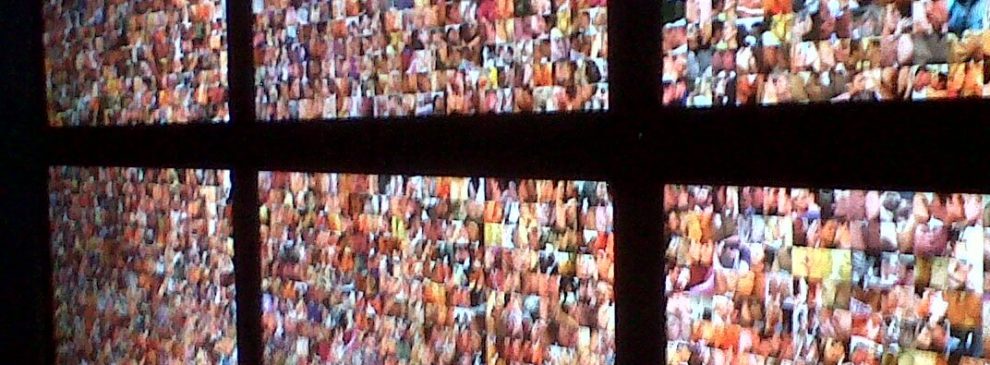How can you bring digital art alive in a city – and why?
Added on Wednesday, February 24th, 2016
| Claire Taylor is Professor in Hispanic Studies at the University of Liverpool and is a specialist in Latin American culture. Her research topics include women’s writing in Latin America and Latin(o) American digital culture. |
In the late 1980s, Bill Gates was famous for building a 22-foot system of screens portraying digital art and photography in his home. He wanted to democratise art. Now, with tablets and digital screens available to us all, digital art is well established. But what can it achieve and how do you bring digital art to life? Here I share what we have learned from the Latin(o) American Digital Art project, which brought artists from Montevideo, Buenos Aires, Santiago de Chile and New York to Liverpool.
The idea of the project was to get our cities in dialogue with each other – and to look at each other’s cities through new eyes and perspective. Thomas McMullen wrote in the Guardian that, ‘As boundaries blur between the digital and the physical, artists are remaking the metropolis into a playful, human experience.’ That is exactly what we wanted to do: bring our cities to life and make them playful experiences. And we hope the findings from this project will be of interest to museums, art festivals, art galleries, community media groups, media labs, digital artist practitioners, and professional associations working with new media.
Based on our experience with the project, Jordana Blejmar and I wrote the Latin(o) American Digital Art Policy Document, which offers a series of observations and recommendations regarding the exhibition spaces for digital artwork, the uses of social media for curation and engagement, and future possibilities for Europe-Latin(o) American artistic collaborations. Here are the three key learning points from the document:
1. Digital must be combined with physical in an exhibition
The question of how digital art can be exhibited in a physical space has been a constant in debates on the exhibition of new media arts (see Stallabrass 2003: 120; London 204-206; Paul 2008: 23-24). Our project concluded that if you are displaying digital art in an exhibition space, the space itself needs to be flexible and include elements of art works – so don’t have digital art just on its own. We chose The Box at FACT for one of our venues because it had flexible furniture to suit different artworks. For example, for Brian Mackern’s Santa Rosa Storm, we arranged furniture to create the impression of a central aisle of a church leading up to an altar.
Other venues were chosen because of their emerging nature – such as recently renovated spaces being turned into cultural and artistic exhibitions. These gave us an opportunity to showcase new art forms, such as the Cabildo in Montevideo.
All of the artworks we selected included physical (offline) interaction as well as online interaction. This meant audience interaction could take multiple forms, including the tactile as well as the virtual. In one art work, for example, the body movement of spectators caused fluctuations to a live flame.
Adapting the artworks and associated events to local spaces created really interesting discussions with the artists and gave everyone a richer understanding of the artworks: adapting the altar used for one artwork into a plinth for displaying robots in another made everyone look at how best to use the materials and spaces.
| ‘All of the artworks we selected included physical (offline) interaction as well as online interaction. This meant audience interaction could take multiple forms, including the tactile as well as the virtual.’ |
2. Engage the public
Physical activities, such as artist talks, workshops and interviews, were run alongside exhibitions. Groups who might not have engaged exclusively online were brought into the discussion. A good example were the workshops at TheMediaLab at FACT with the Veterans in Practice, where there was sharing of best practice and which brought together online and offline audiences.
Social media was also important – such as Twitter galleries which ran throughout the two months of the project. This gave the public a rare glimpse into an artwork as it evolves and gave access to exclusive artwork images. The public could feed into the artwork themselves and proposed other images to incorporate. A live Q&A Twitter chat was scheduled with the artist to create a time window of interest around the events.
3. Digital art presents technology challenges for exhibition spaces
Internet connectivity was critical in the choice of venues. Some spaces were really integrated with the city space but just did not have the infrastructure for digital.
Spaces are therefore a play-off between the aesthetic and practical.
Cross-cultural benefits to a city
There were so many benefits from this project – to both our cities, the artists and audiences. The main ones were:
- Including Latin American artists within the various venues and events brought new audiences to their work
- Everyone was able to share expertise and best practice, especially around tactical media which is well developed and theorised in a Latin American context
- The events led to collaboration with institutions in Liverpool and also those based in other parts of the globe, including Latin America. Possible exchanges, reciprocal ideas and co-sponsoring of events are all being discussed
The organisations involved in this project include FACT (Foundation for Art and Creative Technology), the Independents Liverpool Biennial, the E-Poetry Festival, the Centro Cultural Jorge Luis Borges, the Cabildo de Montevideo, and the Escuela de Defensa Nacional in Buenos Aires.
If you saw any of these exhibitions or have your own digital art experiences to share, please do leave a comment or contact us on Twitter @Claire_Taylor_M.
Photo credits
“Digital arts survey exhibition -DECODE” by Paul Webster Thompson is licensed under CC BY-NC-ND 2.0
“Hand 14” by Golan Levin is licensed under CC BY 2.0









